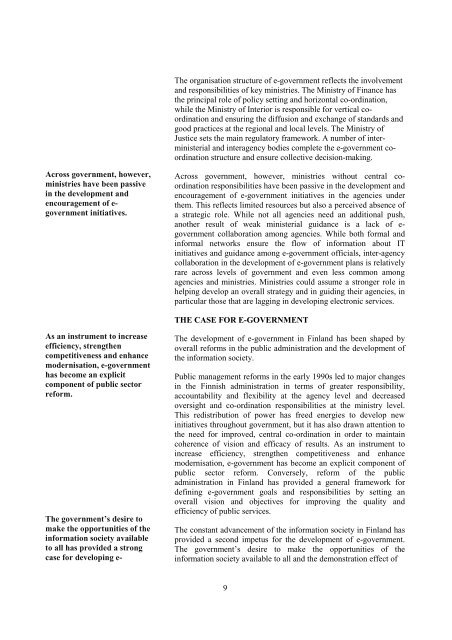e-GOVERNMENT IN FINLAND - ePractice.eu
e-GOVERNMENT IN FINLAND - ePractice.eu
e-GOVERNMENT IN FINLAND - ePractice.eu
Create successful ePaper yourself
Turn your PDF publications into a flip-book with our unique Google optimized e-Paper software.
Across government, however,<br />
ministries have been passive<br />
in the development and<br />
encouragement of egovernment<br />
initiatives.<br />
As an instrument to increase<br />
efficiency, strengthen<br />
competitiveness and enhance<br />
modernisation, e-government<br />
has become an explicit<br />
component of public sector<br />
reform.<br />
The government’s desire to<br />
make the opportunities of the<br />
information society available<br />
to all has provided a strong<br />
case for developing e-<br />
The organisation structure of e-government reflects the involvement<br />
and responsibilities of key ministries. The Ministry of Finance has<br />
the principal role of policy setting and horizontal co-ordination,<br />
while the Ministry of Interior is responsible for vertical coordination<br />
and ensuring the diffusion and exchange of standards and<br />
good practices at the regional and local levels. The Ministry of<br />
Justice sets the main regulatory framework. A number of inter-<br />
ministerial and interagency bodies complete the e-government coordination<br />
structure and ensure collective decision-making.<br />
Across government, however, ministries without central coordination<br />
responsibilities have been passive in the development and<br />
encouragement of e-government initiatives in the agencies under<br />
them. This reflects limited resources but also a perceived absence of<br />
a strategic role. While not all agencies need an additional push,<br />
another result of weak ministerial guidance is a lack of egovernment<br />
collaboration among agencies. While both formal and<br />
informal networks ensure the flow of information about IT<br />
initiatives and guidance among e-government officials, inter-agency<br />
collaboration in the development of e-government plans is relatively<br />
rare across levels of government and even less common among<br />
agencies and ministries. Ministries could assume a stronger role in<br />
helping develop an overall strategy and in guiding their agencies, in<br />
particular those that are lagging in developing electronic services.<br />
THE CASE FOR E-<strong>GOVERNMENT</strong><br />
The development of e-government in Finland has been shaped by<br />
overall reforms in the public administration and the development of<br />
the information society.<br />
Public management reforms in the early 1990s led to major changes<br />
in the Finnish administration in terms of greater responsibility,<br />
accountability and flexibility at the agency level and decreased<br />
oversight and co-ordination responsibilities at the ministry level.<br />
This redistribution of power has freed energies to develop new<br />
initiatives throughout government, but it has also drawn attention to<br />
the need for improved, central co-ordination in order to maintain<br />
coherence of vision and efficacy of results. As an instrument to<br />
increase efficiency, strengthen competitiveness and enhance<br />
modernisation, e-government has become an explicit component of<br />
public sector reform. Conversely, reform of the public<br />
administration in Finland has provided a general framework for<br />
defining e-government goals and responsibilities by setting an<br />
overall vision and objectives for improving the quality and<br />
efficiency of public services.<br />
The constant advancement of the information society in Finland has<br />
provided a second impetus for the development of e-government.<br />
The government’s desire to make the opportunities of the<br />
information society available to all and the demonstration effect of<br />
9
















